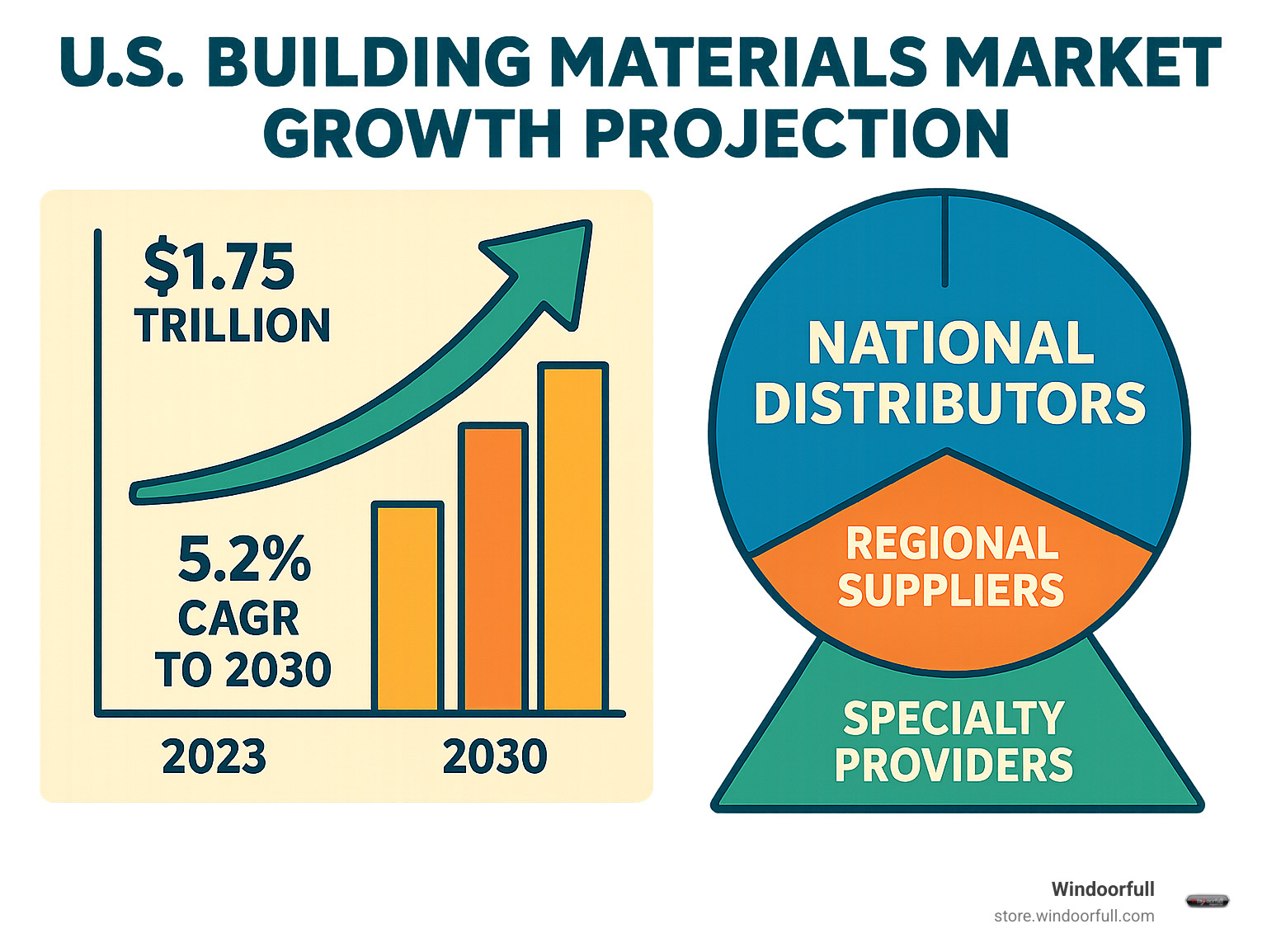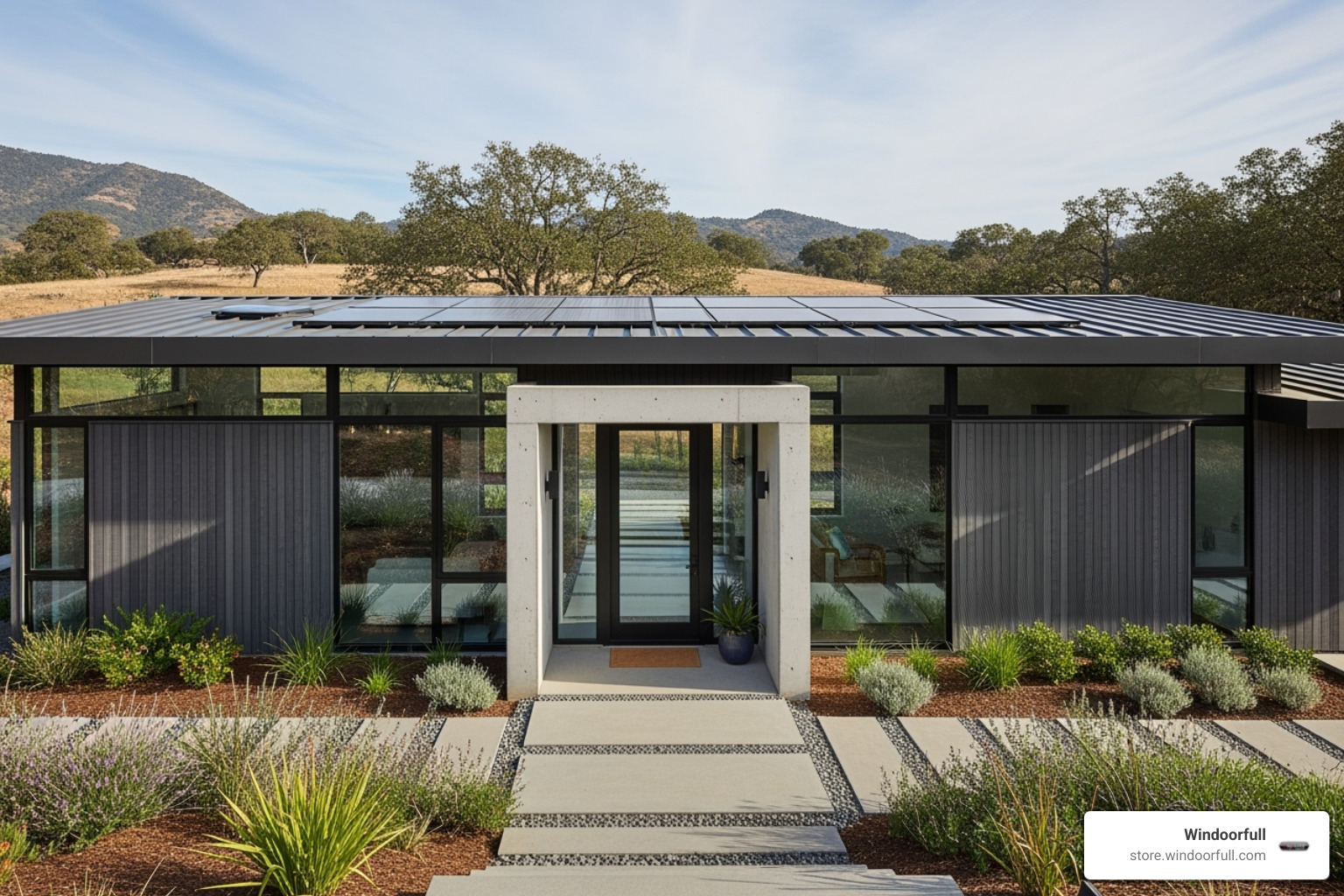
Where to Find the Best Building Materials Across America
Share
Why Finding the Right Building Materials Suppliers Matters More Than Ever
Finding quality building materials usa suppliers can make or break your construction project. With the U.S. construction industry generating over $1.7 trillion in revenue in 2023, the demand for reliable material sources has never been higher. The market is vast, with suppliers falling into several key categories:
- Large national distributors serving professional contractors with extensive networks.
- Major home improvement retailers catering to both professionals and DIY customers.
- Regional and specialty suppliers offering local expertise and high-performance niche products.
The U.S. building materials market was valued at $1.75 trillion in 2023 and is projected to grow at 5.2% annually through 2030. This growth brings both opportunities and challenges for those seeking the best materials for their projects.
Whether you're upgrading your home's windows for better energy efficiency or managing a large commercial build, choosing the right supplier affects everything from project timelines to long-term performance. The key is understanding which suppliers offer the specific products, services, and expertise your project demands.
We specialize in European-engineered windows and doors, I've seen how the right building materials usa suppliers can transform construction outcomes. My experience with high-performance building components has taught me that supplier selection is just as critical as material selection itself.

Understanding the Landscape of Building Materials USA
The building materials usa market is a massive ecosystem serving countless needs, from large commercial projects to DIY renovations. Understanding its components can save you time and money. The market serves two main groups: professional contractors needing bulk supplies and reliable delivery, and DIY homeowners seeking quality materials and advice.
Primary Types of Building Materials
Building materials are the essential ingredients for any project. Structural materials form the foundation. Lumber is the workhorse for residential framing, while steel framing offers strength for commercial buildings. Concrete provides the solid base for most structures.
For the exterior, materials must withstand the elements. Siding options range from wood to fiber cement, while roofing materials like asphalt shingles protect the structure. For projects demanding top-tier performance, Premium Wall Panels and Steel Doors from specialized suppliers like Windoorfull offer improved security and curb appeal.
Inside, interior systems create livable spaces. Drywall provides smooth walls, quality insulation reduces energy costs and noise for greater Peace of Mind: Simple Steps to a Safer Home, and flooring sets the tone for each room.
Types of Suppliers in the USA
The supplier landscape has three main players in the building materials usa market.
National distributors are the heavy hitters, operating hundreds of locations and focusing on professionals. They excel at bulk orders and consistent supply chains for large projects.
Regional suppliers offer local knowledge of building codes, climate challenges, and architectural styles. They often provide more personal service and can adapt to special requests.
Specialty suppliers focus on specific or high-performance products. This is where innovation thrives. Companies like Windoorfull High Performance Building Supply specialize in items like European-engineered windows and doors, providing deep technical knowledge and unique solutions.
Innovations Shaping the Future of Construction
The construction world is changing fast, driven by sustainability, high-performance materials, and the need for energy efficiency. Today's builders are creating structures that perform better, last longer, and have a lighter environmental footprint.

The Rise of Sustainable and High-Performance Materials
Green building principles are now mainstream, as sustainable choices often deliver better long-term value. Energy efficiency is at the heart of this shift, with savings on utility bills making it a practical choice. The focus is on high-performance building envelopes—the home's protective shell. Modern air sealing systems and advanced insulation options work with improved window technology to create truly efficient homes. For example, triple glazing is becoming a practical upgrade for many projects. If you're curious, you can explore if Triple Glazing is the Smart Choice for Your Home. Today's building materials usa must also excel in durability, fire resistance, and moisture management to ensure homes are safe and healthy for decades.
Spotlight on Innovative Building Materials USA
Let's look at some specific innovations reshaping construction.
Magnesium Oxide (MgO) Boards are a fire-resistant drywall alternative with impressive water and mold resistance, making them ideal for humid environments like bathrooms and basements.
Engineered components like pre-cut framing packages reduce waste and speed up construction. These systems improve efficiency and sustainability, with some saving significant amounts of lumber compared to traditional methods.
Advanced window technology is another exciting development. European-style windows with tilt-and-turn functionality are gaining traction in the U.S. market. They offer superior thermal performance, and the tilt feature provides secure ventilation that traditional windows can't match. This combination of flexibility and energy performance is why more homeowners are finding they are The Smart Choice for Modern Homes.
How Technology is Streamlining Material Sourcing
Technology is revolutionizing how we source building materials usa, changing a process of phone calls and paperwork into a streamlined digital experience that saves time and reduces errors.
Digital Tools for Contractors and Homeowners
Modern suppliers offer e-commerce platforms and online portals that work 24/7. These systems show real-time availability, detailed specs, and personalized pricing. You can Shop Online for high-performance products with ease. User-friendly account management tools let you view order history and reorder materials. The biggest game-changer is mobile applications, allowing you to place orders and track deliveries from the job site. Real-time delivery tracking eliminates guesswork, while built-in project calculators and quoting tools help you order the right quantities and reduce waste.
Value-Added Services from Modern Suppliers
Leading building materials usa suppliers now offer services that make projects run smoother. Logistics and delivery have advanced to include on-time scheduling and job site staging, where materials are placed exactly where you need them. Many suppliers also provide design and engineering support for complex projects, helping with material selection and custom solutions. Some even offer installation services or turn-key project completion, handling the process from supply to installation and giving you one less thing to manage.
Key Considerations When Selecting Building Materials
Choosing the right building materials usa is a complex puzzle of balancing budget, timeline, and long-term goals. Making smart decisions requires looking beyond upfront costs to consider regulations, performance, and project-specific demands.
Navigating Building Codes and Regulations
Building codes are essential for safety and quality, and they have a profound impact on material selection. While national standards provide a baseline, local jurisdictions often have unique requirements based on climate and other factors. Always check with your local building department before finalizing choices.
Safety regulations are critical, especially concerning fire ratings for walls and ceilings. Another key area is egress window requirements, which are life-safety rules dictating minimum opening sizes and installation heights. Understanding The Complete Guide to Egress Windows is essential for compliance, and specific guides like Your Guide to 36-Inch Egress Windows: Hopper vs. Side-Hinge can help you choose the right solution. Reputable suppliers ensure their products meet relevant standards, giving you confidence your project will pass inspection.
Balancing Cost, Quality, and Long-Term Value
Smart builders focus on lifecycle costs and long-term value rather than just upfront costs. For example, high-performance windows may cost more initially but deliver significant energy savings over their lifetime, as detailed in The Power of Pennies: Simple Steps to Reduce Your Energy Bills. Similarly, higher-quality materials often have lower maintenance requirements and last longer. Your project scope and climate considerations should also influence your decisions, as a custom home has different needs than a storage shed.
| Feature | Standard Double-Pane Windows (Typical US) | High-Performance Triple-Pane Tilt-and-Turn Windows (e.g., Windoorfull) |
|---|---|---|
| Upfront Cost | Lower | Higher |
| Energy Efficiency | Moderate | Excellent (Superior insulation, reduced drafts) |
| Noise Reduction | Moderate | Excellent (Thicker glass, better seals) |
| Security | Standard (Often single-point lock) | High (Multi-point locking systems) |
| Ventilation Options | Limited (Slide open/crank out) | Versatile (Full swing-in or tilt-in for secure, draft-free airflow) |
| Durability/Lifespan | Good | Excellent (Robust frames, high-quality hardware) |
| Maintenance | Standard | Easy to clean (Swing-in feature allows access to both sides of glass) |
| Long-Term Value | Good | Superior (Significant energy savings, improved comfort, higher resale value) |
The key is to weigh all these factors to make an informed decision that best suits your project's needs, rather than simply choosing the cheapest option.
Frequently Asked Questions about Building Materials in the USA
Navigating building materials usa can bring up many questions. Here are answers to some common queries we receive from professionals and homeowners alike.
What are the most common building materials for a new American home?
For most new homes in the U.S., the core structure relies on a consistent set of materials. You'll typically find wood framing for the skeleton, concrete foundations for a sturdy base, and asphalt shingles for roofing due to their cost-effectiveness. Exteriors often feature durable siding (vinyl, fiber cement, or wood), while interiors are finished with drywall and filled with insulation to ensure comfort and energy efficiency. While these are the staples, many modern homes now incorporate advanced options like high-performance windows for better efficiency.
How can I find sustainable building materials?
Finding sustainable building materials usa is easier than ever. Here are a few key strategies:
- Look for certifications: Seek out labels like Forest Stewardship Council (FSC) for wood, which verifies responsible sourcing. Other certifications like GREENGUARD or Environmental Product Declarations (EPDs) also signal eco-friendly products.
- Prioritize energy efficiency: Materials that improve your home's building envelope, such as high-performance windows and advanced insulation, are inherently sustainable because they reduce long-term energy consumption.
- Check for recycled content and low-VOCs: Many products now use recycled materials, and choosing low-VOC (Volatile Organic Compounds) paints and sealants improves indoor air quality.
- Engage with suppliers: Don't hesitate to ask your suppliers about their green building options and sustainability initiatives. Many leading suppliers are committed to providing environmentally responsible choices.
What are the benefits of European-style windows in the US market?
European-style windows, particularly tilt-and-turn models, are gaining popularity in the U.S. for several compelling reasons. They offer superior thermal performance thanks to multi-chambered frames and triple-glazing options, which leads to significant energy savings. Their standard multi-point locking systems provide improved security compared to typical windows. The unique versatile functionality allows them to either swing open like a door for easy cleaning or tilt inward for secure, draft-free ventilation. Combined with excellent acoustic insulation and low-maintenance durability, they represent a smart, long-term investment for any modern home. To learn more, explore our guide on Euro Windows Unveiled: Top Picks for Seamless Design and Performance.
Conclusion: Building a Better Future
Our journey through building materials usa shows a dynamic industry focused on innovation, efficiency, and durability. The market is robust, and choosing the right materials and suppliers is about making smart, informed decisions for long-term safety, performance, and sustainability.
Technology is making this process easier than ever. Digital ordering and real-time tracking streamline sourcing for contractors and homeowners alike. The shift towards sustainability is also clear, with the rise of materials like fire-resistant Magnesium Oxide (MgO) boards and energy-efficient solutions that save money and protect the environment.
When your project demands top-notch performance, consider all your options. For example, European-engineered tilt-and-turn windows from Windoorfull offer exceptional long-term value through improved comfort, security, and energy savings. It's an investment in quality that lasts.
By embracing innovation and making thoughtful choices, we can all contribute to building a better, more sustainable future, one project at a time.
Want to keep learning and stay ahead of the curve? Explore our news section for more insights on high-performance building components.


